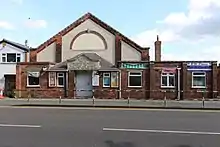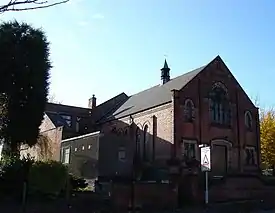William Herbert Higginbottom
William Herbert Higginbottom JP (23 March 1868 - 6 December 1929) was an architect based in Nottingham.
Life
He was born on 23 March 1868 in Leeds to Anthony Higginbottom (1842-1895) and Elizabeth Ackroyd (1844-1913). When he was one year of age, his family moved to Arnold, Nottingham, where his father became the headmaster of the British School.[1]
He married Elizabeth Spencer (1869-1924) on 25 January 1897 at Redcliffe Road Methodist Chapel, Nottingham, and they had the following children:
- Hilda Margaret Higginbottom (1899-1973)
- William Herbert Higginbottom (1899-1899)
- (Anthony) John Higginbottom (1902-1972) LRIBA also an architect
- Elizabeth May Higginbottom (1904-1904)
- Elizabeth Higginbottom (1906-1972)
He died on 6 December 1929 and left an estate valued at £2882 16s 2d.[2] (equivalent to £176,500 in 2019).[3]
Career
He attended the Nottingham School of Art.[4]
For a time he worked from King John's Chambers in Nottingham. In 1905 he moved to an office at 16 George Street, Nottingham[5] but in 1906 he moved to 2 Friar Yard, Friar Lane, Nottingham.[6] along with Hedley John Price.
After qualifying as an architect Higginbottom designed many of the important buildings in Arnold.
He was a local councillor on Arnold Urban District Council and chairman from 1911 to 1913. He was a member of Nottinghamshire County Council, for the Bestwood Park Division, where he worked on the old age pension and highways committees.[1]
Buildings
.jpg.webp)

- St Matthias' Day Schools, Carlton Road, Sneinton, Nottingham 1895 (enlargement)[7]
- Stapleford Schools[1] 1896
- Sir John Robinson’s Almshouses, Daybrook 1899[8]
- Wesleyan Chapel, Arnold[1] 1900
- Carlton Methodist Church, 1903[9]
- Five semi-detached houses, 44-62 Meadow Road, Beeston
- United Methodist Church, Sneinton Boulevard, Sneinton 1904-05[10]
- The Carnegie Library, Arnold[1] 1906[11]
- Calverton Methodist Church, 1907[12]
- Cross Street Baptist Church[1] 1909[13]
- St Albans Picturedrome, Arnold 1912[14] (with George Francis Grimwood)
- Daybrook Baptist Church,[1] 1912
- Ruddington Village Hall[1] 1912-13
- Victoria Picture Palace, 49 Station Road, Carlton[1] 1912-13
- Empress Cinema, Arnold[1] 1913
- Mission Church at Daybrook[1]
- War Memorial Cross, Beeston[1] 1921[15]
- War Memorial in Arnot Hill Park, Arnold[1] 1922
- Chilwell Memorial Institute 1924[1]
- Park House Carlton [1]
- Warehouses on Plumptre Street, Nottingham
- Sunday School, Ebenezer United Methodist Chapel, Arnold 1929[16]
References
- "W H Higginbottom and James Shirtcliff". Arnold Local History Group. Retrieved 28 September 2014.
- "Index of Wills and Administrations, 1858-1995" (1930). England & Wales, National Probate Calendar, p. 182. The National Archives.
- UK Retail Price Index inflation figures are based on data from Clark, Gregory (2017). "The Annual RPI and Average Earnings for Britain, 1209 to Present (New Series)". MeasuringWorth. Retrieved 2 February 2020.
- "Nottingham School of Art List of Awards". Nottingham Evening Post. England. 30 August 1888. Retrieved 15 April 2017 – via British Newspaper Archive.
- "W.H. Higginbottom". Nottingham Journal. England. 18 January 1905. Retrieved 25 June 2020 – via British Newspaper Archive.
- "Notice of Removal". Nottingham Journal. England. 26 March 1906. Retrieved 25 June 2020 – via British Newspaper Archive.
- "St Matthias Day Schools". Nottingham Evening Post. England. 16 April 1895. Retrieved 25 June 2020 – via British Newspaper Archive.
- "The Sandford Robinson Almshouses". Nottingham Journal. England. 4 October 1899. Retrieved 15 April 2017 – via British Newspaper Archive.
- "Methodism at Carlton. New Chapel Opened". Nottingham Evening Post. England. 13 August 1903. Retrieved 15 April 2017 – via British Newspaper Archive.
- "New Methodist Church at Sneinton". Nottingham Evening Post. England. 16 June 1904. Retrieved 15 April 2017 – via British Newspaper Archive.
- "Carnegie Library at Arnold". Nottingham Evening Post. England. 27 October 1906. Retrieved 15 April 2017 – via British Newspaper Archive.
- "The foundation stones of a new Primitive Methodist Chapel at Calverton…". Nottingham Journal. England. 8 April 1907. Retrieved 15 April 2017 – via British Newspaper Archive.
- "New Baptist Chapel at Arnold". Nottingham Evening Post. England. 18 February 1909. Retrieved 15 April 2017 – via British Newspaper Archive.
- "Bonington Theatre, 98 Nottingham Road, Arnold, NG5 6LF". Cinema Treasures. Cinema Treasures. Retrieved 26 June 2020.
- "Beeston's Heroes. Celtic Memorial Cross Unveiled". Beeston Gazette and Echo. England. 28 May 1921. Retrieved 25 June 2020 – via British Newspaper Archive.
- "Arnold Stone Laying". West Bridgford Times & Echo. England. 21 June 1929. Retrieved 25 June 2020 – via British Newspaper Archive.
